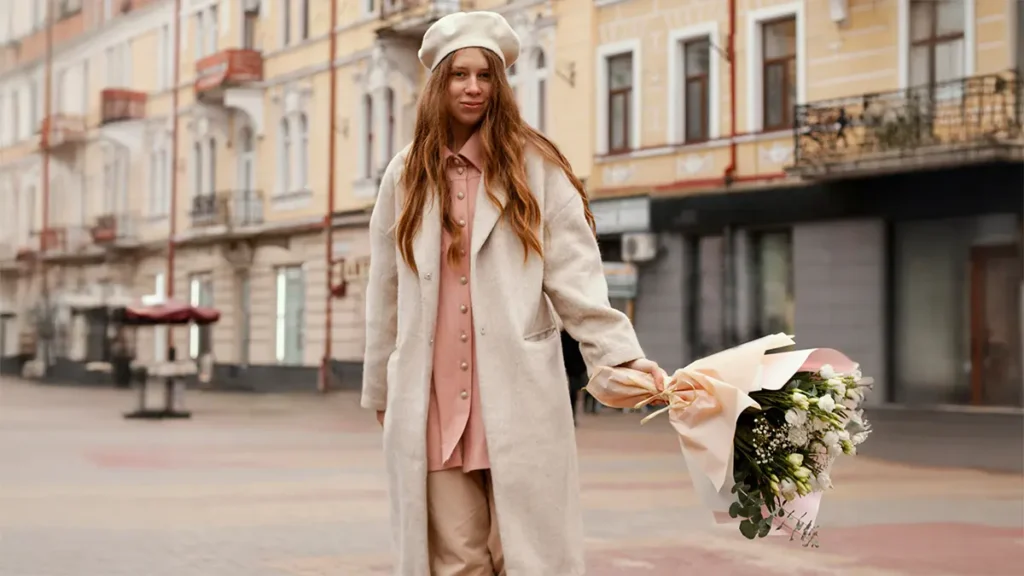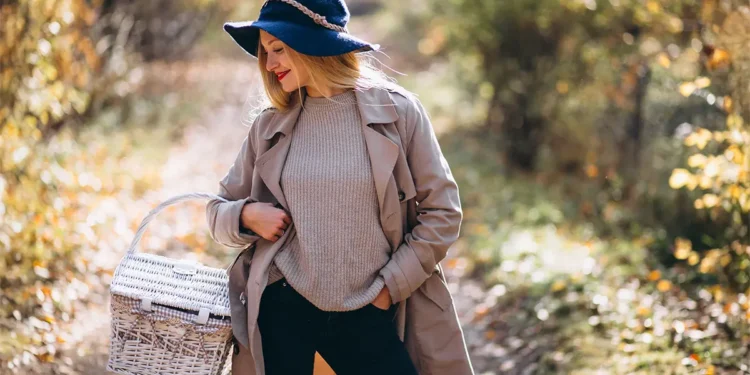Layer Clothes for Spring in the UK is an essential skill if you want to stay comfortable, stylish, and prepared for anything the weather throws your way—and let’s be honest, it can throw a lot.
Spring weather in Britain isn’t just unpredictable—it’s borderline chaotic. You could wake up to a misty, chilly morning that calls for a jumper and coat, only to find yourself roasting in unexpected sunshine by midday. And just when you start thinking it’s safe to wear lighter clothes, a sudden downpour or gust of wind reminds you it’s still not summer.
The trick to dressing for spring is not trying to guess the weather. It’s dressing in a way that lets you adjust as the day changes. That’s why layering works. It’s simple, practical, and once you get the hang of it, you’ll wonder how you ever managed without it.
So, Why Layer at All?
Let’s be honest—we’ve all been there. You leave the house bundled up, only to get to work and feel like you’re in a sauna. Or worse, you dress lightly thinking it’ll stay sunny, and you’re shivering by lunchtime.
That’s where layering saves the day.
Instead of relying on a single thick coat or guessing what the weather might do, layering gives you options:
- If it gets warm, take a layer off.
- If it cools down, throw one back on.
- If it rains, you’ve got something to protect you.
It’s about having control over how your outfit performs throughout the day. And it’s not just for fashion lovers—it’s for anyone who doesn’t want to spend their day too hot, too cold, or soaked to the skin.
Start With a Comfortable Base
Think of your base layer as your second skin. It’s what you wear first, closest to your body, and it sets the tone for how the rest of your outfit feels.
This layer should be breathable, comfortable, and soft. You don’t want anything too thick or heavy here—this is all about comfort and temperature control.
Good base layer choices include:
- A fitted cotton T-shirt – classic, versatile, and easy to pair with anything.
- A long-sleeve top – great for those cooler spring mornings.
- A lightweight thermal – ideal if you run cold or the forecast is still sitting under 10°C.
This layer needs to breathe. That’s why cotton is king here. If you go for synthetic fabrics (like polyester), you might feel fine when you put it on—but once the temperature rises or you start moving around, things can get sweaty fast.

Add Warmth, But Make It Flexible
This is where you start building in warmth—but the key word here is removable.
The middle layer is what you take off when the sun comes out, or add back on when the temperature dips. It needs to be easy to wear, easy to pack, and ideally something you don’t mind carrying if you need to take it off.
Middle layer go-tos:
- A soft wool jumper
- A fitted hoodie
- A cardigan
- A thin fleece
When it comes to materials, merino wool is brilliant. It’s light, naturally breathable, and helps regulate your temperature, which means you’re less likely to overheat even when you’re indoors or on public transport.
The goal here is insulation without bulk. You want something that warms you up without making you feel like you’ve wrapped yourself in a blanket.
The Outer Layer Is Your Shield
Now we’re talking protection. The outer layer is what shields you from the wind, rain, and general unpredictability of spring.
You don’t want anything too thick or heavy—you’ve already done the warming bit underneath. What you need here is something practical, lightweight, and easy to throw on.
Top outer layer choices for spring:
- A classic trench coat – smart, timeless, and works with anything.
- A packable waterproof jacket – keep it in your bag in case of a surprise shower.
- A bomber jacket or denim jacket – perfect for dry, breezy days when you don’t need full coverage.
It’s worth investing in a coat that’s water-resistant and windproof. Even if it’s not raining when you leave, spring showers are sneaky. Having a light raincoat or trench nearby means you’re covered (literally) without lugging around a heavy winter coat.
Also—don’t underestimate the power of a foldable umbrella. Stick one in your bag and forget it’s there until you need it.
Think About Fabrics
One of the biggest layering mistakes people make is wearing the wrong materials. You might have the right number of layers, but if they’re made from the wrong stuff, you’ll end up hot, sweaty, and annoyed.
The best spring-friendly fabrics:
- Cotton – breathable, soft, and ideal for base layers.
- Merino wool – perfect for insulation without bulk.
- Cashmere – warm, light, and looks good doing it.
- Linen – great for warmer spring days; just expect some creasing.
- Silk – soft, sleek, and ideal under jackets or jumpers.
👎 Avoid synthetics like acrylic or full polyester layers. They don’t breathe and can turn your nice walk into a sweaty mess by the time you reach the train.
Evenings Out? Still Layer Smart
Spring evenings can be misleading. You head out while it’s sunny and warm, then spend the whole night freezing because the temperature dropped ten degrees.
Here’s a go-to spring evening outfit that works:
- Tailored trousers or dark jeans
- A silk or satin blouse
- A light wool blazer or jacket
- Smart flats or leather loafers
It’s a clean, classic look that gives you just enough warmth without making you look overdressed. And remember—if your outfit includes lighter shoes, don’t forget a pair of invisible socks. Cold feet will ruin your evening.
Accessories Make a Big Difference
Don’t underestimate the power of a few small extras. The right accessories can keep you warm without adding weight or bulk.
Spring layering extras to consider:
- A light scarf – great for mornings or breezy days.
- Fingerless gloves – still handy for early spring chills.
- A beanie or beret – not just a winter look anymore.
- A crossbody bag or tote – to carry that jumper or waterproof layer when the sun comes out.
Layering Tips That Actually Work
Let’s wrap up the strategy with some quick, no-nonsense advice.
✅ Stick to 3 layers
More than three, and it gets clunky. Three gives you warmth, comfort, and flexibility.
✅ Keep it neutral
Greys, blacks, navy, and beige all work well together. Less time matching, more time living.
✅ Avoid double-bulky layers
Don’t pair a chunky jumper with a thick coat—it gets too heavy and awkward.
✅ Don’t forget your bag
Make sure it’s big enough to carry your jacket or jumper if the sun makes an appearance.
✅ Always do a final outfit check
Move around. Can you stretch? Lift your arms? Sit down comfortably? You’re good to go.
Mastering how to Layer Clothes for Spring isn’t about being a fashion expert—it’s about being smart with your outfit so you’re not caught off guard by the weather. Whether it’s a misty morning, sunny lunchtime, or breezy evening, the right layers will carry you through the day with comfort and style.
Start with a breathable base, add a layer of warmth, finish with a weatherproof outer—and make sure each piece can stand on its own. Before you know it, you’ll be layering like a pro.
And once you get it right? You’ll never fear spring weather again.
Layer Clothes for Spring FAQ
Q: How many layers should I wear in spring?
A: To layer clothes for spring, three layers usually work best—a base layer (like a T-shirt), a middle layer for warmth (like a jumper), and an outer layer for weather protection (like a trench coat or light rain jacket). You can remove or add layers depending on the temperature throughout the day.
Q: Can I still wear winter clothes in spring?
A: You can, but go easy. Ditch the thick winter coat and heavy knits. Instead, use lighter pieces like merino wool jumpers or a midweight coat. Spring is about balance—not bulk.
Q: What’s the best jacket for unpredictable spring weather?
A: A lightweight, water-resistant trench coat is ideal. It handles rain, wind, and chilly mornings without feeling too heavy. A packable waterproof jacket is also great to keep in your bag for sudden showers.
Q: Are boots okay in spring?
A: Yes—but switch to lighter styles. Ankle boots or Chelsea boots work well early in the season. As it warms up, you can move into loafers, trainers, or even ballet flats.
Q: What are some quick accessories to keep warm without layering too much?
A: Try a lightweight scarf, a thin beanie, or fingerless gloves. These extras add warmth without weighing you down, and they’re easy to stash in your bag when you don’t need them.
Layer Clothes for Spring the right way, and you’ll always be ready—whatever the forecast decides to do.







